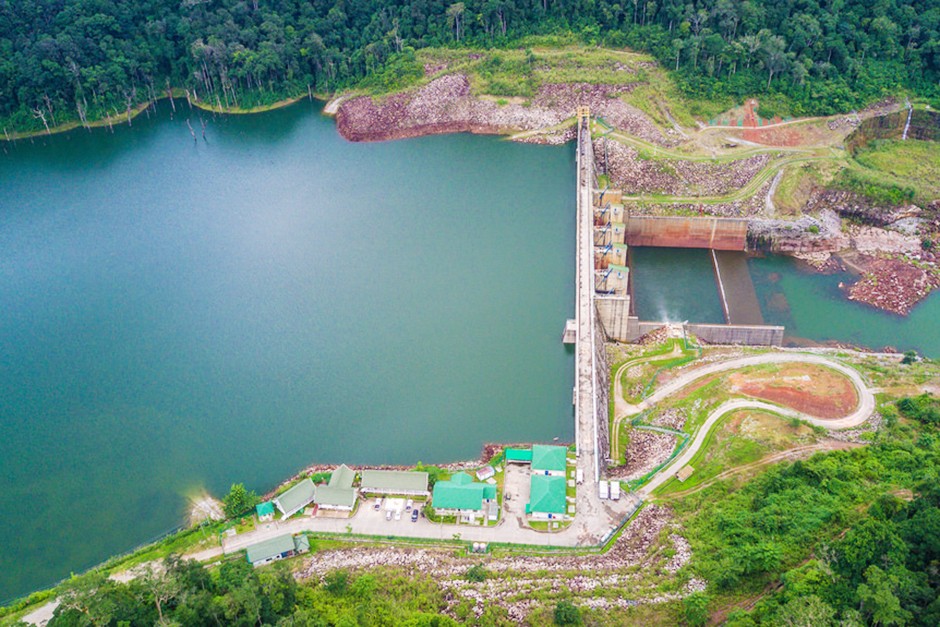Keeping digitalisation green: APAC governments hold key to unlocking renewables’ vast potential

A stable supply of renewable energy is key to sustainable digitalisation efforts. Governments should remove regulatory hurdles, incentivise corporate renewable energy investment and support digital technologies to accelerate sustainability innovation, said experts at the AWS Sustainability Summit 2022.
The Nam Theun 2 hydroelectric dam in Laos. Earlier this July, Singapore announced it will be importing up to 100 megawatts (MW) of electricity from Laos through Malaysia and Thailand. The project is Singapore's first renewable energy import, and ASEAN's first multilateral cross-border electricity exchange. Image: Asian Development Bank via Flickr
As the world confronts the growing urgency of the climate crisis, hyperscale computing companies are stepping up their sustainability efforts. In recent years, cloud titans have emerged as the largest buyers of renewable energy, with the clean energy portfolios of Big Tech sometimes rivalling those of the world’s biggest utilities.
According to latest data from Bloomberg NEF, Amazon has been the largest corporate clean energy purchaser in the world for the second year straight. Globally, a total of 6.2 gigawatts (GW) of renewable energy was purchased in 2021 through 44 offsite power purchase agreements (PPAs) in nine countries by the tech giant. The company now has 310 renewable energy projects around the globe, with capacity to generate over 15.7 gigawatts of energy, making it one of the world’s clean energy leaders.
However, despite the growing ambition and appetite of these companies, their 100-per-cent-renewable energy goals remain out of reach in some parts of Asia, primarily due to a lack of affordable clean power options.
Ken Haig, who leads Amazon Web Services (AWS)’s energy and environment policy engagement efforts, says governments in the region can encourage corporate renewable investments by setting up regulatory frameworks that incentivise the adoption of affordable and renewable energy. “Leading renewable energy purchasers and cloud service providers can drive the demand for clean energy and help the sector to grow, bringing with it associated capital, green jobs and the proliferation of green technologies and approaches across Asia Pacific,” he said.
Haig, who also chairs the Asia Cloud Computing Association (ACCA)’s Sustainability Working Group, was speaking at AWS’s annual Asia Pacific Sustainability Summit held on 29 June. Experts on the same panel also said that overcoming the lack of financing, accurate information and confidence will give the region the breakthrough it needs.
Enabling renewable energy projects in Asia Pacific
Earlier this month, Singapore announced it would be importing up to 100 megawatts (MW) of hydropower from Laos via Thailand and Malaysia in the first multilateral cross-border electricity trade involving four ASEAN countries. With increasing regional collaboration, foreign imports of renewable energy for renewables-scarce Singapore, will become increasingly possible. This will not only boost investor confidence in such projects, but also make the sustainable construction and operation of digital infrastructure more achievable.
Heng Jian Wei, director (policy) at the National Climate Change Secretariat (NCCS) in the Prime Minister’s Office - Strategy Group (Singapore), said: “Such projects can help spur the growth of renewable energy resources, which can be used to power the grid in the host countries as well. They are powerful as they create a win-win outcome.”
He further explained that renewable energy projects can make better financial sense if sufficient offtakers are secured, and by reducing upfront costs and enabling downstream recovery.
Haig added that Amazon’s renewable energy strategy focuses on additionality. “We identify projects to invest in as offtakers enabling additional renewable energy to help green the grids where we operate. This is what we have done in APAC as well with three projects in Australia, two in China, and one each in Singapore and Japan,” he said.
AWS is currently on track to meet its pledge of using 100 per cent renewable energy by 2025, five years earlier than expected.
Asian Development Bank’s (ADB) senior energy specialist Stephen Peters cited the international help given to construct Cambodia’s 100MW National Solar Park Project, as a further example of how governments can make renewable energy projects more economically viable and less financially daunting.
In addition to ADB’s US$7.64 million loan, the project was also given a US$11 million concessional loan and a US$3 million grant from the Climate Investment Fund’s Scaling Up Renewable Energy Programme (SREP). With funding from 14 donor countries, SREP aims to help resource-strapped nations fight the impacts of climate change and accelerate their shift to a low-carbon economy.
The project, the first of its kind in Cambodia, adopts reverse auctioning as a strategy for the government to procure renewable energy generation capacity. The competition drives down the power purchase tariff for solar. “The model was very successful because it allows risks to be shared between the public and private sectors based on who can best handle the risk. This avoids premiums due to misallocated risk and produces low energy prices,” said Peters.
Pursuing ‘green growth’ for Asia’s data centres
Data centre operators are now facing pressure to meet stricter sustainability goals. In Singapore, a moratorium on data centres, once imposed due to sustainability concerns such as the heavy electricity and water usage of the facilities, was lifted in January this year, but with regulations to ensure that their power usage effectiveness (PUE) is kept at 1.3 or below. Moreover, applications to operate new centres must include innovation and sustainability solutions, and applicants should ideally have a proven track record in building and operating data centres.
At the summit, strategic economic consultancy AlphaBeta launched a paper detailing how Singapore could achieve a “green growth” scenario, where there is ample, sustainable digital infrastructure, by providing assistance to data centres sourcing for renewable energy.






